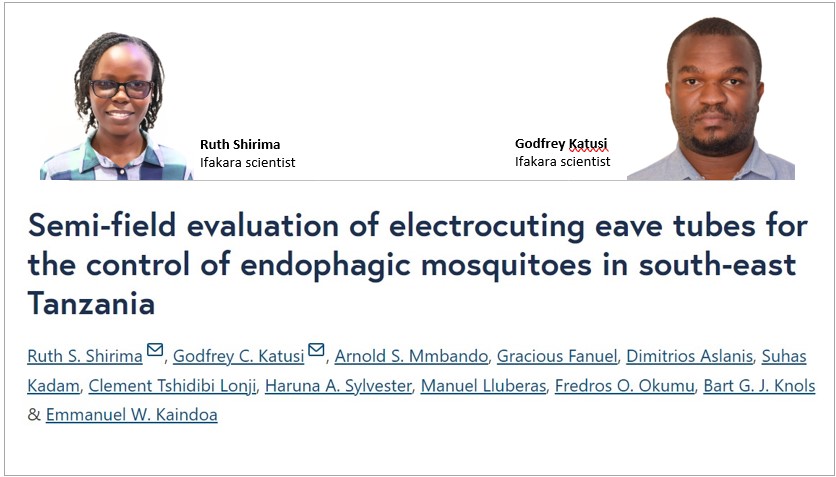
INNOVATION: This tool can reduce mosquito population in homes

A promising tool called Mosquito Electrocuting Eave Tubes (MEETs) has demonstrated the potential to significantly reduce malaria-carrying mosquitoes in homes by targeting them at one of their main entry points – the eaves.
Scientists at Ifakara Health Institute tested this innovative intervention and confirmed its effectiveness in killing mosquitoes and lowering their numbers, thereby reducing malaria transmission.
The team, led by Ruth Shirima and Godfrey Katusi, evaluated MEETs' performance against two primary malaria vectors, Anopheles gambiae s.s. and Anopheles funestus s.s., in semi-field conditions at the institute’s ‘mosquito city’ facility near Ifakara, southeast Tanzania.
Although the results were promising, the scientists suggest that further validation of the tool's potential under natural field conditions is necessary.
In their publication on the Parasites & Vectors journal, they note, “MEETs represent a promising tool for controlling mosquitoes at the point of house entry… MEETs not only provide household protection but may also provide communal protection by mass killing, but this aspect needs to be confirmed in open field trials.”
The challenge of eave spaces
Malaria remains a major public health challenge in sub-Saharan Africa, partly due to traditional housing designs that facilitate mosquito entry, contributing to mosquito transmission.
In many homes across the region, eave spaces – openings near the roof designed to improve indoor ventilation – often become entry points for mosquitoes, particularly Anopheles species, responsible for spreading malaria.
Existing solutions and their limitations
Current interventions to address this issue include insecticide-treated screens, curtains, ribbons, and tubes, as well as biological control methods using fungi. While these methods have been effective, challenges such as insecticide resistance limit their long-term success, underscoring the need for alternative solutions that don’t promote resistance.
This study demonstrates the effectiveness of MEETs showing how the tool can significantly reduce the number of mosquitoes recaptured indoors.
What are Mosquito Electrocuting Eave Tubes (MEETs)?
MEETs are a novel tool designed to kill mosquitoes as they enter through eaves, reducing their ability to bite humans inside the house. Unlike traditional insecticide-based methods, MEETs use an electrical current to electrocute and kill mosquitoes upon contact, potentially offering a more sustainable solution.
Assessing the efficacy of MEETs on mosquitoes
The study, the first to directly assess the efficacy of MEETs on mosquitoes, was conducted under semi-field conditions with experimental huts equipped with MEETs. Scientists installed six MEETs in each hut and assessed their effectiveness over ten nights. Anopheles gambiae and Anopheles funestus mosquitoes were released into these huts to measure the impact of MEETs on mosquito numbers.
Results showed that the placement of MEETs significantly reduced the number of mosquito bites. Specifically, for Anopheles gambiae, MEETs reduced indoor biting by 21.1% and outdoor biting by 37.4%. while for Anopheles funestus, indoor and outdoor biting decreased by 87.5% and 10.4%, respectively.
These reductions highlight the potential of MEETs to significantly lower mosquito populations and, by extension, reduce the risk of malaria transmission, noted the scientists.
The possibility of implementing MEETs
The study also explored the feasibility of implementing MEETs in rural areas without access to electricity. The scientists pointed out that recent advancements in solar technology could make it possible to power MEETs using solar energy, which would also enhance community acceptance.
“Future use of MEETs will likely require their use in areas where houses lack electricity. Given the rapid developments in solar technology, solar conversion efficiency and decreasing costs, it will be relatively easy to run MEETs off-grid in this manner. Moreover, access to solar energy in communities without access to electricity may enhance acceptance of mosquito control tools.”
While the study's results are promising, the scientists noted several limitations, including the use of laboratory-reared mosquitoes and the semi-field setting. They emphasized the need for further trials in real-world conditions to confirm the efficacy of MEETs which could become a scalable and accessible solution, providing household protection in malaria-endemic regions.
Ifakara scientists lead the study
The study was led by Ifakara Health Institute scientists Ruth Shirima and Godfrey Katusi, who served as lead authors, with Bart Knols and Emmanuel Kaindoa as joint last authors.
Additional contributors included Arnold Mmbando and Fredros Okumu from Ifakara, Gracious Fanuel from Robotics from Scratch (Tanzania), Dimitrios Aslanis and Clement Tshidibi Lonji from Diastec Ltd (UK), Suhas Kadam from College of Agriculture (India), Haruna Sylvester from Phoenix University Agwada (Nigeria), and Manuel Lluberas from Mosquito Den LLC (Puerto Rico).
Read the publication here.
